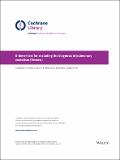D-dimer test for excluding the diagnosis of pulmonary embolism
Date
05/08/2016Metadata
Show full item recordAbstract
Background Pulmonary embolism (PE) can occur when a thrombus (blood clot) travels through the veins and lodges in the arteries of the lungs, producing an obstruction. People who are thought to be at risk include those with cancer, people who have had a recent surgical procedure or have experienced long periods of immobilisation and women who are pregnant. The clinical presentation can vary, but unexplained respiratory symptoms such as difficulty breathing, chest pain and an increased respiratory rate are common. D‐dimers are fragments of protein released into the circulation when a blood clot breaks down as a result of normal body processes or with use of prescribed fibrinolytic medication. The D‐dimer test is a laboratory assay currently used to rule out the presence of high D‐dimer plasma levels and, by association, venous thromboembolism (VTE). D‐dimer tests are rapid, simple and inexpensive and can prevent the high costs associated with expensive diagnostic tests. Objectives To investigate the ability of the D‐dimer test to rule out a diagnosis of acute PE in patients treated in hospital outpatient and accident and emergency (A&E) settings who have had a pre‐test probability (PTP) of PE determined according to a clinical prediction rule (CPR), by estimating the accuracy of the test according to estimates of sensitivity and specificity. The review focuses on those patients who are not already established on anticoagulation at the time of study recruitment. Search methods We searched 13 databases from conception until December 2013. We cross‐checked the reference lists of relevant studies. Selection criteria Two review authors independently applied exclusion criteria to full papers and resolved disagreements by discussion. We included cross‐sectional studies of D‐dimer in which ventilation/perfusion (V/Q) scintigraphy, computerised tomography pulmonary angiography (CTPA), selective pulmonary angiography and magnetic resonance pulmonary angiography (MRPA) were used as the reference standard. • Participants: Adults who were managed in hospital outpatient and A&E settings and were suspected of acute PE were eligible for inclusion in the review if they had received a pre‐test probability score based on a CPR. • Index tests: quantitative, semi quantitative and qualitative D‐dimer tests. • Target condition: acute symptomatic PE. • Reference standards: We included studies that used pulmonary angiography, V/Q scintigraphy, CTPA and MRPA as reference standard tests. Data collection and analysis Two review authors independently extracted data and assessed quality using Quality Assessment of Diagnostic Accuracy Studies‐2 (QUADAS‐2). We resolved disagreements by discussion. Review authors extracted patient‐level data when available to populate 2 × 2 contingency tables (true‐positives (TPs), true‐negatives (TNs), false‐positives (FPs) and false‐negatives (FNs)). Main results We included four studies in the review (n = 1585 patients). None of the studies were at high risk of bias in any of the QUADAS‐2 domains, but some uncertainty surrounded the validity of studies in some domains for which the risk of bias was uncertain. D‐dimer assays demonstrated high sensitivity in all four studies, but with high levels of false‐positive results, especially among those over the age of 65 years. Estimates of sensitivity ranged from 80% to 100%, and estimates of specificity from 23% to 63%. Authors' conclusions A negative D‐dimer test is valuable in ruling out PE in patients who present to the A&E setting with a low PTP. Evidence from one study suggests that this test may have less utility in older populations, but no empirical evidence was available to support an increase in the diagnostic threshold of interpretation of D‐dimer results for those over the age of 65 years.
Citation
Crawford , F , Andras , A , Welch , K , Sheares , K , Keeling , D & Chappell , F 2016 , ' D-dimer test for excluding the diagnosis of pulmonary embolism ' , Cochrane Database of Systematic Reviews , no. 8 , CD010864 . https://doi.org/10.1002/14651858.CD010864.pub2
Publication
Cochrane Database of Systematic Reviews
Status
Peer reviewed
ISSN
1469-493XType
Journal item
Collections
Items in the St Andrews Research Repository are protected by copyright, with all rights reserved, unless otherwise indicated.

